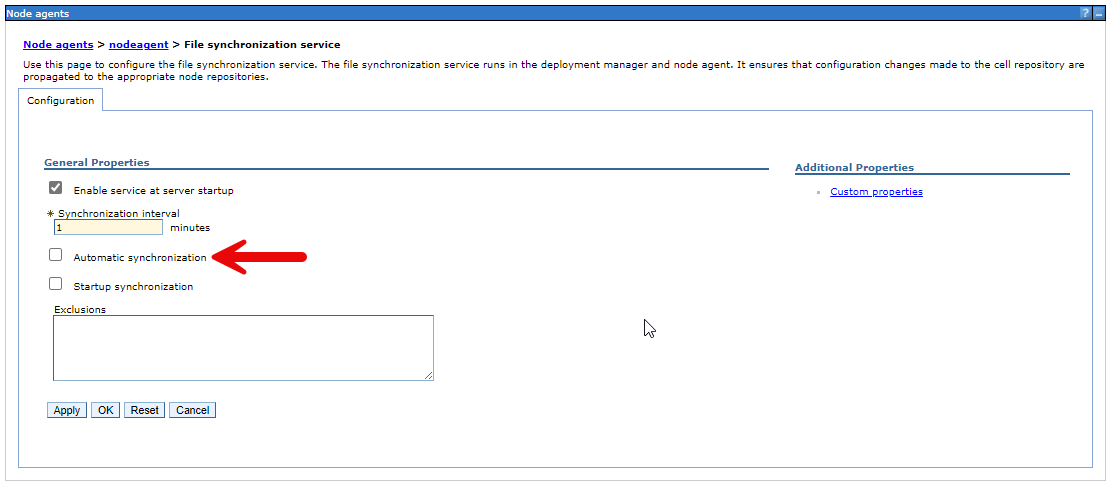
This assumes you have already used IBM's Installation Manager to install the cumulative fix.
- IBM Installation Manager - Install using imcl install command
- IBM Installation Manager - Install using imcl input command (response.xml)
Refer to IBM Portal - Configuring wkplc.properties for the steps on how to configure the workplace properties file (wkplc.properties) so that applyCF.sh can make a connection to Portal.
The applyCF.sh script will open a large number of files. The recommendation is to have the open files limit set to 200,000 open files, or more. Refer to Linux Commands - ulimit to set the open files limit to 200,000 or greater. Note that the limit must be set on both the deployment manager and the node servers.
Before using the applyCF.sh script, each node agents automatic synchronization must be disabled. Check out my article IBM WebSphere - Enable or Disable Synchronization for more details on this.

Additionally, you should probably stop the application servers (JVMs) before issuing the applyCF.sh command. Check out my article IBM WebSphere - Start Stop or Restart an application server.
The applyCF.sh script is used to install the cumulative fix.
- Refer to IBM Portal - wkplc.properties PortalAdminPwd to determine -DPortalAdminPwd
- Refer to IBM Portal - wkplc.properties WasPassword to determine -DWasPassword
/opt/WebSphere/AppServer/profiles/<your profile>/PortalServer/bin/applyCF.sh -DPortalAdminPwd=<password> -DWasPassword=<password>
If the build is successful, something like this should be displayed.
BUILD SUCCESSFUL
isIseries currently set to: null
update-registry-sync-property:
[echo] updated RegistrySynchronized in file wkplc.properties with value: true
print-final-message:
Return code = 0
deleting temporary files
SUCCESS: Update to Cumulative Fix completed successfully.
After a successful build, the WPVersionInfo command can be used to ensure Portal was brought up to the new version of the cumulative fix.
~]$ /opt/WebSphere/PortalServer/bin/WPVersionInfo.sh
Installed Component
--------------------------------------------------------------------------------
Name IBM WebSphere Portal Configuration Framework
Version 8.5.0.0
Installed Fix CF210
ID CFGFW
Build Level 20230307-192248 2023-03-07
Build Date 03/07/2023
Or using the WPHistoryInfo command.
~]$ /opt/WebSphere/PortalServer/bin/WPHistoryInfo.sh
Installation Event
--------------------------------------------------------------------------------
Offering ID com.ibm.websphere.PORTAL.SERVER.v85
Action update
Version CF210 for v8.5, v9.0 and v9.5
Package com.ibm.websphere.PORTAL.SERVER.v85_8.5.0.20230307_1621
Log File Name 20240522_0018a.xml
Timestamp 2024-05-22T00:18:59-05:00
Result SUCCESS
Installed Features Config Engine
Installed Features Portal Server Binary
Then you can go head and enabled each node agents automatic synchronization.

And if the application servers (JVMs) are not up and running, start the JVMs. Check out my article IBM WebSphere - Start Stop or Restart an application server.
If you have web servers federated into the dmgr, I would also generate the plugin-cfg.xml files. Check out my article IBM WebSphere - Generate web server plugin (plugin-cfg.xml) using the dmgr.
And then propagate the web server plugin-cfg.xml to each web server. Check out my article IBM WebSphere - Propagate web server plugin (plugin-cfg.xml) using the dmgr.
Did you find this article helpful?
If so, consider buying me a coffee over at 